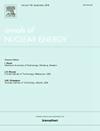Research on variable speed operation scheme for mobile microreactor coupled with helium gas turbine cycle
IF 1.9
3区 工程技术
Q1 NUCLEAR SCIENCE & TECHNOLOGY
引用次数: 0
Abstract
The micro high temperature gas-cooled reactor coupled with gas turbine direct cycle has the characteristics of inherent safety, high outlet temperature and no phase change of working medium. It is a competitive mobile microreactor technology scheme. Mobile microreactors mainly operate in remote off-grid areas, and need to cope with frequent load power variations. They mainly operate in variable speed mode. While, there are few studies on the variable speed operation characteristics of mobile microreactors. In this paper, a 10MWth mobile microreactor coupled with helium gas turbine cycle (MMR-GT) is selected as research object, and the differential algebraic equations mathematical model is established. The system analysis program is developed based on Modelica language. Firstly, the characteristics of MMR-GT under constant speed and variable speed operation schemes are compared when 100pcm reactivity is inserted and the load power varies the same. In variable speed operation, the performance parameters of turbomachinery changes more obviously than that in constant speed operation. Then, the steady-state operation characteristics of MMR-GT at different rotational speed is analyzed. With the decrease of speed, the power of each component, mass flow rate and system pressure all drop rapidly. The recuperator effectiveness is higher at low flow rate, and it is increased by 15.5% when the rotational speed is reduced to 60% of the rated value. Finally, the response of MMR-GT to load power fluctuations is analyzed. Without inserting external reactivity, the decrease of load power leads to the increase of rotational speed and flow rate, the decrease of reactor outlet temperature, and the rise in reactor power due to negative feedback effect. For load power increase, the positive reactivity needs to be inserted to increase driving torque. The speed control scheme is tested for partial load power loss. It indicates that the shaft speed can be controlled at the set value through bypass valve.
移动微反应器与氦气轮机循环耦合的变速运行方案研究
燃气轮机直接循环耦合的微高温气冷堆具有固有安全、出口温度高、工质无相变等特点。这是一个具有竞争力的移动微反应器技术方案。移动微堆主要运行在偏远的离网地区,需要应对频繁的负荷变化。它们主要以变速模式运行。而对移动微反应器变速运行特性的研究较少。本文以10mw移动式微反应器与氦轮机循环耦合(MMR-GT)为研究对象,建立微分代数方程数学模型。基于Modelica语言开发了系统分析程序。首先,比较了在插入100pcm反应度且负载功率相同的情况下,MMR-GT在恒转速和变速运行方案下的特性。在变速工况下,叶轮机械的性能参数比恒速工况变化更明显。然后,分析了不同转速下MMR-GT的稳态运行特性。随着转速的降低,各部件功率、质量流量和系统压力均迅速下降。低流量时,回热器效率较高,转速降至额定值的60%时,效率提高15.5%。最后,分析了MMR-GT对负载波动的响应。在不插入外反应性的情况下,负荷功率的降低导致转速和流量的增加,反应堆出口温度的降低,由于负反馈效应导致反应堆功率的上升。当负载功率增加时,需要插入正反应性以增加驱动转矩。对该调速方案进行了部分负载功率损耗的试验。说明可以通过旁通阀将轴转速控制在设定值上。
本文章由计算机程序翻译,如有差异,请以英文原文为准。
求助全文
约1分钟内获得全文
求助全文
来源期刊

Annals of Nuclear Energy
工程技术-核科学技术
CiteScore
4.30
自引率
21.10%
发文量
632
审稿时长
7.3 months
期刊介绍:
Annals of Nuclear Energy provides an international medium for the communication of original research, ideas and developments in all areas of the field of nuclear energy science and technology. Its scope embraces nuclear fuel reserves, fuel cycles and cost, materials, processing, system and component technology (fission only), design and optimization, direct conversion of nuclear energy sources, environmental control, reactor physics, heat transfer and fluid dynamics, structural analysis, fuel management, future developments, nuclear fuel and safety, nuclear aerosol, neutron physics, computer technology (both software and hardware), risk assessment, radioactive waste disposal and reactor thermal hydraulics. Papers submitted to Annals need to demonstrate a clear link to nuclear power generation/nuclear engineering. Papers which deal with pure nuclear physics, pure health physics, imaging, or attenuation and shielding properties of concretes and various geological materials are not within the scope of the journal. Also, papers that deal with policy or economics are not within the scope of the journal.
 求助内容:
求助内容: 应助结果提醒方式:
应助结果提醒方式:


